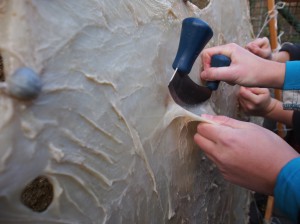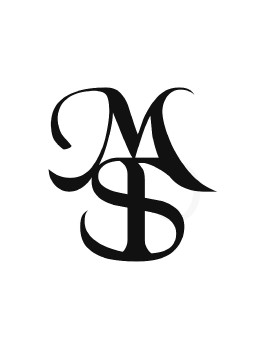Blog - výroba pergamenu
Stenčovanie nožmi
 V blogu o pregamene sme si spomínali, že koža sa musí namočiť vo vápne, aby šli odstrániť chlpy. To ale nie je ani zďaleka hotový produkt.
V blogu o pregamene sme si spomínali, že koža sa musí namočiť vo vápne, aby šli odstrániť chlpy. To ale nie je ani zďaleka hotový produkt.
Pri koži a pregamene rozlišujeme dve strany - srstnú a mäsovú. Srstná je tá, ako nám už napovedá samotný názov, ktorá bola pokrytá srsťou. Z nej sa práve namáčaním vo vápne uvolnia vlasové folikuly a srsť je možné bez väčšej námahy odstrániť. Takúto kožu nazývame "holina". Mäsová strana bola kedysi upevnená na zvierati, je to vnútorná strana kože.
Z mäsovej strany je odchlpená holina pokrytá zbytkami mäsa, vrstvou blán, ciev a podkožného tuku, ktorých je potreba sa zbaviť, aby mohol vzniknúť povrch dostatočne hladký na písanie.
Na stenčovanie holiny slúži oblý nôž zvaný lunellum (zo slova luna, latinsky mesiac). Holina počas tohto procesu musí byť pevne natiahnutá na rám, a keďže ostránenie podkožných blán spôsobí väčšiu elastickosť, upnutie treba postupne viac a viac uťahovať. Keď je povrch dostatočne hladký, zo srstnej strany sa lunou zoškriabu posledné zbytky zabudnutej srsti, a zároveň sa tak odstráni časť epitelovej vrstvy (pokožky).
Takto spracovaný pergamen sa stále pevne natiahnutý na rám nechá vyschnúť a následne sa z rámu vyreže, nechávajúc na ráme stále upnuté 1-2cm hrubé okraje spolu s kamienkami, pomocou ktorých sa na rám naťahoval.
Podľa potreby a určenia pergamenu sa ďalej môže brúsiť pieskom, pemzou alebo sépiovou kosťou, a potierať bielobou. Pergamen určený na písanie sa často takto brúsi/drsní, zato pergamen určený na maľovanie (napríklad botanických kresieb) zostáva hladký, bez akejkoľvek ďalšej úpravy povrchu.
EN
In the "what is a parchment" blog, we wrote about the process of parchment making and mentioned that the skin is soaked in lime to loosen the hair. But that is still far from the finished product. With membrane, we differentiate between two sides of the hide - the hair side and the flesh side. Hair side, as the name tells, is the side where the hair grows. The lime bath helps to loosen the hair folicles from this side, which then allows for the hair to be removed quite easily. Such a hide is called a pelt. The flesh side was once attached to the animal, it is the inner side of the skin. On this side, the pelt is covered in the residue of flesh, blood vessels, subcutaneous tissue and fat, all of which must be removed to create a surface smooth enough for writing. To remove these and to further thin the pelt, the pelt is scraped with semi-circular knife called lunellum (from luna, latin word for moon, because of the crescent shape of the knife). The pelt must be stretched in a frame, called herse, and it has to be tightened several times as the subcutaneous tissue removal allows for greater elasticity of the skin. When the surface is smooth enough, the hair side it slightly scraped as well to remove any left out hair and a layer of epidermis. After this, the parchment is left tightly stretched on the herse to dry and then it is cut out, leaving some 1-2cm margin along with the pebbles (used to help grab on the skin with the twine) still attached to the frame. Surface of the parchment can be further adjusted to accommodate the needs of its use, for example parchment used for calligraphy is sanded with pumice powder and whitened (with zinc oxide or white lead), while the parchment for botanical paintings is left completely smooth without any additional surface treatment.
.

